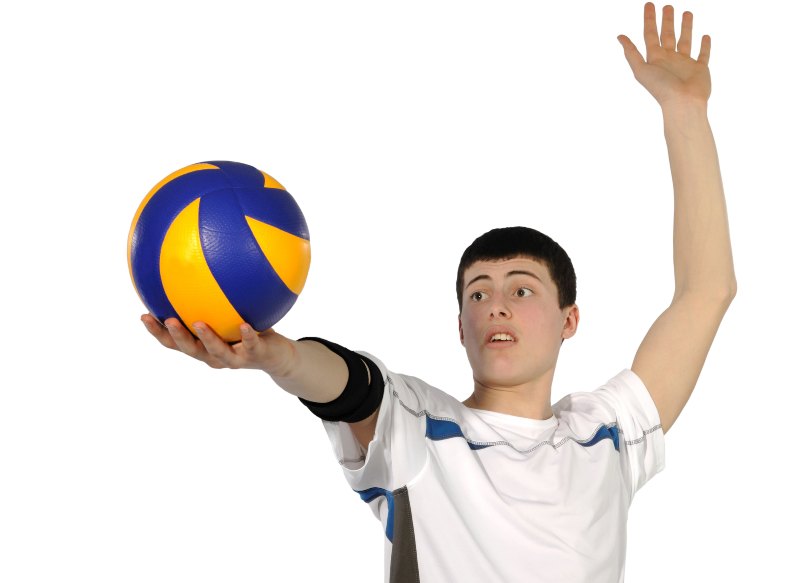
To play any sport at the highest level possible, it is always recommended to get started as early as possible. Volleyball is no exception to that …
However, it was observed that many youngsters start seriously thinking about volleyball at the age of 16 give or take. Yet, they remain reluctant as they are not sure whether it is too late or not to get started at that age.
In this article I breakdown, pretty in details, the proper way to properly get started in this sport at that age and how you can evolve pretty quickly.
Is it too late to start volleyball at age of 16?
In most cases, it might be too late to become an elite volleyball player, yet there is no reason why somebody should not start playing volleyball at the age of 16 …
Indeed, a ton of benefits could be gained even if it is just about practicing at a recreational level like …
- Burning calories and fat
- Tuning and shaping the body
- Increases the metabolic rate
- Improving hand-eye coordination
- Building confidence agility, speed, and balance
- Increases aerobic ability.
It is also psychologically beneficial because it helps to reduce stress while, at the same time boosting self-confidence, self-esteem, and increases the desire to succeed.
Playing volleyball can make people feel good about themselves and their team mates and can help with issues surrounding body image and physical appearance.
Above all, though, playing volleyball is fun and an enjoyable pastime!
Quick Recommendation: If you are just getting started in volleyball, then, I highly recommend you check this helpful resource. You will learn the most important rules, skills and approaches you need to implement in volleyball to fasten your learning process.
How to get in volleyball shape at 16?
16-year olds just cannot expect to begin playing volleyball and hope to enjoy the physical demands of the sport without putting in some hard work first.
And that begins with diet …

Avoid fast food and unhealthy meals like processed foods, and stick to eating healthy to help promote your growth.
It is important to hydrate regularly, by drinking between six and eight glasses of water a day.
Exercises should aim to be active for at least one hour a day. That does not mean necessarily visiting a gym, but could involve walking, riding a bike or swimming at a local pool.
Consider putting together a workout plan … This should start with the basics, such as push-ups, pull-ups, and sit-ups, and, for those who have access to weights, could expand to squats, curl, and bench presses.
To aid the exercise process, always warm up and cool down before and afterwards with some gentle stretching exercises. This helps prevent injury and can help maximise the efficiency of the work-out in terms of calories burned.
What volleyball gear to start with?
Assuming that the basic infrastructure is in place –a ball, a net, and a court or space in which to play – and that there are enough people to make-up two teams, then, beyond that, there is some minimum equipment that the average 16-year old will need to start laying volleyball.
Using the right shoes (Check this example here at Amazon) are more important than what you might think …
While the game can be played in regular footwear, volleyball shoes are specially designed for the game, They are bigger and lighter and come with a gum rubber sole to provide maximum traction. They are also designed to protect the ankles and provide top support to guard against sprains.
Jerseys and shorts are also a prerequisite. Volleyball is a fast moving, hectic sport and it is important to war loose fitting clothing that does not impeded movement and provides plenty of ventilation.
At that age also, young players may want to wear both knee pads and sleeves (Like those). An inevitable fact of life in volleyball is that, at some stage in a game, a player is likely to make contact with the floor in the course of a play.
Knee pads help prevent cut, grazes and friction burns, and sleeves perform a similar function, except for the arms in their cases. Knowing they have some protection against the minor injuries that may occur whilst playing the game can make all the difference for some younger players.
Volleyball Skills a 16 years old kid should focus on
Passing is regarded as the most important skill of all in volleyball. Without the ability to pass the ball from one player to another, the chances of scoring a point are remote.
Serving is often neglected as a skill, A good serve does not just have to clear the net but it should be difficult for the opposition to return easily. Serving is not just a means of getting the ball back in play, but executed properly, represents an attacking opportunity, even if producing an ace may be beyond the capabilities of most 16-year olds.
Another underrated skill, and probably the one least taught by coaches is blocking. Although often thought as a defensive move, somebody who learns how to block properly can often be the difference between winning and losing a game, and even some of the best hitters in the game are also excellent blockers in their own right. This role is particularly suited to taller players.
The setting position is considered the key role on court, because it involves creating the play that will, hopefully. Lead to the opportunity for the spikers. It can take years to master this position, but all youth players should at least familiarise themselves with some of the requirements involved.
Finally, players need to learn how to dig the ball up when retrieving the serve or a pass.
Best Volleyball Drills for that age
Ball Hitting
Players can practice their hitting by lining-up with the ball in front of their hitting shoulder, and then striking the ball into the floor using the entire circumference of their striking hand.
Toss Up
This drill helps teach players the correct ball and body position whilst setting. Players should stand with one foot slightly in front of the other, and then toss the ball over their head before catching it with the fingers spread.
Low Catch Passing
To get players accustomed to catching the ball in a low position,, they should toss the ball high in the air, allow it to bounce once, and then catch it before it hits the floor second time round.
Serve Receive
Both servers and receivers get to practice their skills with this drill, Servers send the ball over the net of an opposing passer who must try and return the ball to a designated player. After five minutes the pair should swap positions or another designated target should be nominated.
Flip Flop Passing
This involves three players, Two of them take turns tossing balls to a passer in between them. After passing the ball to the first tosser, the passer turns round and returns the ball to the second tosser.
After five minutes, the players should change positions.
Importance of joining a Club at that age …
There are a number of reasons for a young player to join a volleyball club.
The first and most obvious one is that volleyball is a team game, and, in its indoor version at least, it needs a minimum of six players a side to play it. That means that, unless somebody has a plentiful and ready supply of friends and family who want to take up the sport as well a club is the best place to meet like-minded individuals.
Another good reason to join is to have access to coaching. While volleyball is a relatively simple game to understand, there are a number of techniques that need to be learned in order to play it properly and get the maximum of enjoyment from it.
It is possible to teach yourself, but most people will learn better if they have an expert coach to guide them. And the best place to find such people is at a club where they will already be working.
Last, but certainly not least, especially for recreational players, is the social aspect. Volleyball is a team game where individuals collaborate and cooperate with each other, People met on the volleyball court can become close friends for life. And clubs may arrange extra-curricular activities that provide further opportunities for social interaction.
You can learn more about the right age where kids should join a volleyball club!
Mistakes to avoid at that young age …
One common mistake that young players make, not only with volleyball but with all sports, is playing too often. Volleyball is an intense sport and one that taxes the muscles, particularly among those who have not yet completed their physical development yet.
The other common mistakes are all to do with a lack of technique or inexperience.
For example, especially with young hitters, it is not unusual for them to approach the ball too quickly. This makes it difficult to play the ball with any accuracy or control, and also makes it difficult to judge the speed of the ball.
It is not unusual for receivers of the serve to have their hands on their knees when standing at the back of the court. This too, is an error, because it makes it harder to react and move if the ball comes to them, or they need to get involved in the subsequent play.
Another frequent error is not to take the eye off the ball before playing it. This is easy to do, because there can be a lot going on the court around them, but concentration must be maintained if the pass, dig, or hit is to be executed properly.
Final Thoughts …
One big mistake that most youngsters make at the age of 16 is that they have big stakes. Indeed, they plan on becoming semi-pros or even pros and play at the highest level as quickly as possible …
Basically, there is nothing wrong with that, but the problem is that they rush and push themselves too hard which might result not only in causing injuries but also missing on the some very important skills that usually take a lot of time to properly learn.
For example, it is known that serving is a skill that usually takes 18 to 36 months for beginners to properly master. Planning on learning it in 3 months is a mistake.
Finally, you can also learn how you can start playing volleyball at the ages from 13 to 14!
